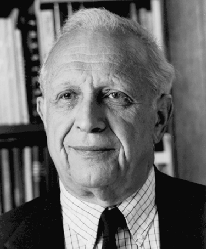Quantum Optikers Win Nobel

Roy Glauber 2005 Nobel Prize in Physics
Well I’m excited! Three quantum optikers, my specialty, today were awarded the Nobel Prize in Physics. One scientist worked out a theory describing the behavior of light using quantum mechanics and the other two scientists used the knowledge to develop a powerful laser technique for identifying atoms and molecules.
Half of the prize goes to Roy Glauber, 80, a professor of physics at Harvard, for calculations that laid the foundation for quantum optics.
John Hall, 71, a physicist at the National Institute of Standards and Theodor Hänsch, 63, a physicist at the Max Planck Institute of Quantum Optics in Garching, Germany, share the other half of the prize, for later work that uses ultrashort laser pulses to make precise measurements.
One of the baffling properties light is that it sometimes acts like waves while at other times it appears to consist of discrete particles (photons).
Einstein established the existence of photons in describing the photoelectric effect, work that won him the Nobel Prize (not Relativity). Scientists developed theories to describe how one or a few photons interact with matter, sometimes like billiard balls. But they lacked a good understanding of the collective behavior of many, many photons.
"It occurred to me around the early 60's that … one had better develop the quantum theory (of light) to the fullest extent mathematically possible" Dr. Glauber said.
Glauber was intrigued by astronomical observations of the star Sirius by Robert Hanbury Brown and Richard Q. Twiss, who counted photons from Sirius using two identical detectors 20 feet apart. The expectation was that photons from Sirius would arrive randomly like raindrops, but instead the scientists detected a pattern in the arrival of photons in the two detectors.
Dr. Glauber's theory showed how the patterns of bunching, called coherence, could emerge during the photons' travel to Earth. His theory is also fundamental to using light in quantum computers and quantum cryptography, the use of quantum mechanics to create an unbreakable code.
Decades later, Dr. Hall and Dr. Hänsch built upon that work developing a technique called the optical frequency comb that uses short pulses of laser light like a ruler to measure the color, or frequency, of light, accurate to one part in one-quadrillion.
At the University of Rochester the quantum optics group was led by two Brits who were part of the 1960s brain drain, Emil Wolf and Leonard Mandel. Their speciality was optical coherence and I was one of a long succession of grad students who benefited from their brilliant guidance. Mandel is dead now, but Wolf in his eighties is still a prolific theoretician and extraordinary teacher.
I remember one of the earliest teacher evaluations in the late 60s when we had the opportunity to comment about our prof’s. The comments were published. Someone wrote that the University ought to pay Wolf a million dollars and make him teach all the classes. Mandel was not far behind him.

3 Comments:
QUANTUM OPTIKERS !!! YOUR SPECIALTY !!!??
Good grief, Bill, I never even heard of such a thing!
Dori
Thanks Bill, that was very interesting. I wonder if all of the emanations from other stars, etc. to earth have some meaning other than light?
Ken
Bill,
Thank you for the article; I enjoyed reading it very much.
Laz
Post a Comment
Subscribe to Post Comments [Atom]
<< Home